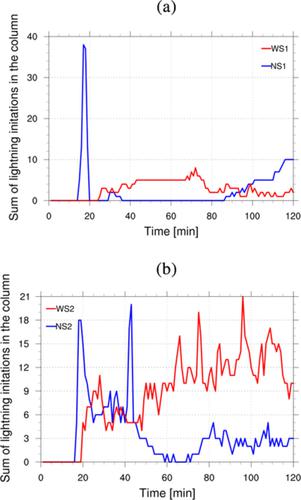当前位置:
X-MOL 学术
›
Meteorol. Appl.
›
论文详情
Our official English website, www.x-mol.net, welcomes your feedback! (Note: you will need to create a separate account there.)
Influence of tilting effect on charge structure and lightning flash density in two different convective environments
Meteorological Applications ( IF 2.7 ) Pub Date : 2020-10-08 , DOI: 10.1002/met.1957 Maryam Gharaylou 1 , Nafiseh Pegahfar 2 , Majid M. Farahani 1
Meteorological Applications ( IF 2.7 ) Pub Date : 2020-10-08 , DOI: 10.1002/met.1957 Maryam Gharaylou 1 , Nafiseh Pegahfar 2 , Majid M. Farahani 1
Affiliation

|
The influence of the tilting effect on charge density and lightning flash density was investigated using idealized Weather Research and Forecasting explicit charging/discharge module (WRF‐ELEC) simulations for two thunderclouds. No shear (NS) and with shear (WS) simulations were conducted based on different values of wind velocity components in input sounding. Results from the NS and WS simulations show that the tilting effect extended the lifetime of the simulated convective clouds in both case studies, while leading to higher maximum vertical velocity only for the environment with intense convection. The ice and graupel in the cloud cell appear almost simultaneously in both the NS and WS simulations for the two case studies, but larger values are obtained for the WS simulations. It is noted that the increase of convection intensity postpones the larger values to the mature stage. The tilting effect results in an increase of total non‐inductive charging, especially in a severe thundercloud. Moreover, the tilting effect does not lead to the same results for the polarity and intensity of charge density in the two studied cases. In the real case study, a dipolar charge structure was seen for both NS and WS simulations, but the intensity of charge density decreased with regard to the tilting effect. In contrast, the intensity of the charge increased with the tilting effect and resulted in tripolarity in the idealized case with a high value of convective available potential energy. Finally, considering the tilting effect leads to an increase of the number of lightning occurrences in the two case studies.
中文翻译:

两种不同对流环境下倾斜效应对电荷结构和闪电密度的影响
使用理想化的天气研究和天气预报显式充/放电模块(WRF-ELEC)模拟研究了两个雷云的倾斜效应对电荷密度和闪电密度的影响。基于输入测深中风速分量的不同值,没有进行剪切(NS)和进行剪切(WS)模拟。NS和WS模拟的结果表明,在两个案例研究中,倾斜效应都延长了模拟对流云的寿命,而仅在强对流环境中才导致更高的最大垂直速度。在两个案例研究中,NS和WS模拟中云单元中的冰和gra几乎同时出现,但WS模拟获得的值更大。注意,对流强度的增加将较大的值推迟到成熟阶段。倾斜效应会导致总的非感应充电增加,特别是在严重的雷雨云中。而且,在两种研究情况下,倾斜效应不会导致电荷密度的极性和强度得到相同的结果。在实际案例研究中,NS和WS模拟都看到了偶极电荷结构,但电荷密度的强度随倾斜效应而降低。相反,电荷的强度随着倾斜效应而增加,并且在理想情况下具有高对流可用势能的值而导致三极性。最后,在两个案例研究中,考虑倾斜效果会导致雷电发生次数增加。
更新日期:2020-10-11
中文翻译:

两种不同对流环境下倾斜效应对电荷结构和闪电密度的影响
使用理想化的天气研究和天气预报显式充/放电模块(WRF-ELEC)模拟研究了两个雷云的倾斜效应对电荷密度和闪电密度的影响。基于输入测深中风速分量的不同值,没有进行剪切(NS)和进行剪切(WS)模拟。NS和WS模拟的结果表明,在两个案例研究中,倾斜效应都延长了模拟对流云的寿命,而仅在强对流环境中才导致更高的最大垂直速度。在两个案例研究中,NS和WS模拟中云单元中的冰和gra几乎同时出现,但WS模拟获得的值更大。注意,对流强度的增加将较大的值推迟到成熟阶段。倾斜效应会导致总的非感应充电增加,特别是在严重的雷雨云中。而且,在两种研究情况下,倾斜效应不会导致电荷密度的极性和强度得到相同的结果。在实际案例研究中,NS和WS模拟都看到了偶极电荷结构,但电荷密度的强度随倾斜效应而降低。相反,电荷的强度随着倾斜效应而增加,并且在理想情况下具有高对流可用势能的值而导致三极性。最后,在两个案例研究中,考虑倾斜效果会导致雷电发生次数增加。



























 京公网安备 11010802027423号
京公网安备 11010802027423号